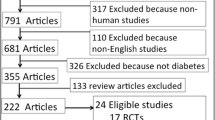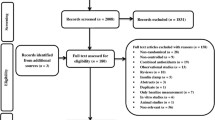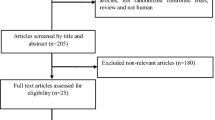Abstract
Purpose
We tested whether short-term vitamin D supplementation improves insulin resistance in patients with kidney disease, a condition with little intrinsic vitamin D activity.
Methods
PubMed, EMBASE and CENTRAL were searched for relevant observational studies and randomized clinical trials (RCTs). Random-effects models were employed for meta-analysis, and effect sizes were summarized as standardized mean difference (SMD) with 95 % confidence intervals. Separate analyses were done for RCTs and non-randomized intervention studies (NRIS).
Results
Seventeen studies (5 RCTs and 12 NRIS) were included. The meta-analysis population (n = 131) was mostly middle aged (40–50 years), male and non-diabetic, and on hemodialysis. The duration (4–12 weeks) and type of supplementation varied between studies. Among RCTs, compared to placebo, vitamin D supplementation was associated with significant decrease in fasting glucose [SMD −1.13, (−2.11 to −0.11)] and PTH levels [SMD −1.50, (−2.95 to −0.04)] but no difference in fasting insulin levels [SMD 1.32, (−0.15 to 2.79)]. Among NRIS, there was only a significant decrease in PTH levels [SMD −1.68, (−2.55 to −0.82)] between pre- and post-vitamin D treatment levels.
Conclusions
Short-term (4–12 weeks) supplementation with vitamin D is associated with lower fasting glucose levels in ESRD with no change in fasting insulin levels. However, the findings from this study are limited by the studies that were used in the meta-analysis, which were mostly small, used multiple different vitamin D compounds and dosing regimens, and had large heterogeneity, and funnel plots showed that there was a dearth of studies with null or negative finding. Therefore, larger RCTs need to be performed to answer this important clinical question.



Similar content being viewed by others
References
Singh B, Saxena A (2010) Surrogate markers of insulin resistance: a review. World J Diabetes 1(2):36–47
de Boer IH (2008) Vitamin D and glucose metabolism in chronic kidney disease. Curr Opin Nephrol Hypertens 17(6):566–572
Fliser D, Pacini G, Engelleiter R, Kautzky-Willer A, Prager R, Franek E, Ritz E (1998) Insulin resistance and hyperinsulinemia are already present in patients with incipient renal disease. Kidney Int 53(5):1343–1347
Hung AM, Ikizler TA (2011) Factors determining insulin resistance in chronic hemodialysis patients. Contrib Nephrol 171:127–134
Jones G (2007) Expanding role for vitamin D in chronic kidney disease: importance of blood 25-OH-D levels and extra-renal 1alpha-hydroxylase in the classical and nonclassical actions of 1alpha,25-dihydroxyvitamin D(3). Semin Dial 20(4):316–324
Holick MF (2007) Vitamin D deficiency. New Engl J Med 357(3):266–281
Maestro B, Campion J, Davila N, Calle C (2000) Stimulation by 1,25-dihydroxyvitamin D3 of insulin receptor expression and insulin responsiveness for glucose transport in U-937 human promonocytic cells. Endocr J 47(4):383–391
Norman AW, Frankel JB, Heldt AM, Grodsky GM (1980) Vitamin D deficiency inhibits pancreatic secretion of insulin. Science 209(4458):823–825
Dusso AS, Brown AJ, Slatopolsky E (2005) Vitamin D. Am J Physiol Ren Physiol 289(1):F8–F28
Sergeev IN, Rhoten WB (1995) 1,25-Dihydroxyvitamin D3 evokes oscillations of intracellular calcium in a pancreatic beta-cell line. Endocrinology 136(7):2852–2861
Mak RH (1992) Intravenous 1,25 dihydroxycholecalciferol corrects glucose intolerance in hemodialysis patients. Kidney Int 41(4):1049–1054
Mak RH (1992) Amelioration of hypertension and insulin resistance by 1,25-dihydroxycholecalciferol in hemodialysis patients. Pediatr Nephrol 6(4):345–348
Mak RH (1998) 1,25-Dihydroxyvitamin D3 corrects insulin and lipid abnormalities in uremia. Kidney Int 53(5):1353–1357
Hung AM, Sundell MB, Plotnikova NE, Bian A, Shintani A, Ellis CD, Siew ED, Ikizler TA (2013) A pilot study of active vitamin D administration and insulin resistance in African American patients undergoing chronic hemodialysis. J Ren Nutr 23(3):185–193
Reeves BC, Deeks JJ, Higgins JPT, Wells GA (2008) Chapter 13: including non-randomized studies. In: Higgins JPT, Green S (eds) Cochrane handbook for systematic reviews of interventions. Version 5.0.1 [updated September 2008]. The cochrane collaboration. www.cochrane-handbook.org
Takeshima N, Sozu T, Tajika A, Ogawa Y, Hayasaka Y, Furukawa TA (2014) Which is more generalizable, powerful and interpretable in meta-analyses, mean difference or standardized mean difference? BMC Med Res Methodol 14:30. doi:10.2286/1471-2288-14-30
Cohen J (1988) Statistical power analysis for the behavioral sciences, 2nd edn. Erlbaum, Hillsdale
Higgins JP, Thompson SG, Deeks JJ, Altman DG (2003) Measuring inconsistency in meta-analyses. BMJ 327(7414):557–560
Deeks JJ, Higgins JPT, Altman DG (2008) Chapter 9: analysing data and undertaking meta-analyses. In: Higgins JPT, Green S (eds) Cochrane Handbook for Systematic Reviews of Interventions. Version 5.0.1 [updated September 2008]. The cochrane collaboration. www.cochrane-handbook.org
Furlan AD, Pennick V, Bombardier C, van Tulder M (2009) Editorial Board CBRG: 2009 updated method guidelines for systematic reviews in the Cochrane Back Review Group. Spine 34(18):1929–1941
Lind L, Lithell H, Wengle B, Wrege U, Ljunghall S (1988) A pilot study of metabolic effects of intravenously given alpha-calcidol in patients with chronic renal failure. Scand J Urol Nephrol 22(3):219–222
Quesada JM, Martin-Malo A, Santiago J, Hervas F, Martinez ME, Castillo D, Barrio V, Aljama P (1990) Effect of calcitriol on insulin secretion in uraemia. Nephrol Dial Transpl 5(12):1013–1017
Turk S, Yeksan M, Tamer N, Gurbilek M, Erdogan Y, Erkul I (1992) Effect of 1,25 (OH)2D3 treatment on glucose intolerance in uraemia. Nephrol Dialysis Transpl 7(12):1207–1212
Lin SH, Lin YF, Lu KC, Diang LK, Chyr SH, Liao WK, Shieh SD (1994) Effects of intravenous calcitriol on lipid profiles and glucose tolerance in uraemic patients with secondary hyperparathyroidism. Clin Sci (Lond) 87(5):533–538
Lu KC, Shieh SD, Lin SH, Chyr SH, Lin YF, Diang LK, Li BL, Sheu WH, Ding YA (1994) Hyperparathyroidism, glucose tolerance and platelet intracellular free calcium in chronic renal failure. Q J Med 87(6):359–365
Kautzky-Willer A, Pacini G, Barnas U, Ludvik B, Streli C, Graf H, Prager R (1995) Intravenous calcitriol normalizes insulin sensitivity in uremic patients. Kidney Int 47(1):200–206
Gunal AI, Celiker H, Celebi H, Ustundag B, Gunal SY (1997) Intravenous alfacalcidol improves insulin resistance in hemodialysis patients. Clin Nephrol 48(2):109–113
Khajehdehi P, Taheri S (2003) Effect of oral calcitriol pulse therapy on the lipid, calcium, and glucose homeostasis of hemodialysis-patients: its safety in a combination with oral calcium carbonate. J Ren Nutr 13(2):78–83
Strozecki P, Kretowicz M, Odrowaz-Sypniewska G, Manitius J (2004) The influence of intravenous 1,25(OH)2D3 therapy on glucose metabolism in hemodialyzed patients with secondary hyperparathyroidism. Ren Fail 26(4):345–348
Blair D, Byham-Gray L, Lewis E, McCaffrey S (2008) Prevalence of vitamin D [25(OH)D] deficiency and effects of supplementation with ergocalciferol (vitamin D2) in stage 5 chronic kidney disease patients. J Ren Nutr 18(4):375–382
Bonakdaran S, Ayatollahi H, Mojahedi MJ, Sharifipoor F, Shakeri M (2008) Impact of treatment with oral calcitriol on glucose intolerance and dyslipidemia(s) in hemodialysis patients. Saudi J Kidney Dis Transpl 19(6):942–947
Ibrahim MA, Sany D, El Shahawy Y, Awdallah A (2012) Effect of activated vitamin D on glucoparameters in HCV seropositive and seronegative patients on chronic hemodialysis. Ren Fail 34(10):1188–1194
Ulutas O, Taskapan H, Taskapan MC, Temel I (2013) Vitamin D deficiency, insulin resistance, serum adipokine, and leptin levels in peritoneal dialysis patients. Int Urol Nephrol 45:879–884
Duranton F, Rodriguez-Ortiz ME, Duny Y, Rodriguez M, Daures JP, Argiles A (2013) Vitamin D treatment and mortality in chronic kidney disease: a systematic review and meta-analysis. Am J Nephrol 37(3):239–248
Palmer SC, Gregor DO, Makaskill P, Craig JC, Elder GJ, Strippoli GFM (2007) Meta-analysis: Vitamin D compounds in chronic kidney disease. Ann Intern Med 147(12):840–853
Thompson SG, Higgins JPT (2002) How should meta-regression analyses be undertaken and interpreted? Stat Med 21(11):1559–1574
De Boer IH, Sachs M, Hoofnagle AN, Utzschneider KM, Kahn SE, Kestenbaum B, Himmelfarb J (2013) Paricalcitol does not improve glucose metabolism in patients with stage 3–4 chronic kidney disease. Kidney Int 83(2):323–330
Thadhani R, Appelbaum E, Pritchett Y, Chang Y, Wenger J, Tamez H, Bhan I, Agarwal R, Zoccali C, Wanner C et al (2012) Vitamin D therapy and cardiac structure and function in patients with chronic kidney disease: the PRIMO randomized controlled trial. JAMA J Am Med Assoc 307(7):674–684
Autier P, Boniol M, Pizot C, Mullie P (2014) Vitamin D status and ill health: a systematic review. Lancet Diabetes Endocrinol 2(1):76–89
Ascaso JF, Pardo S, Real JT, Lorente RI, Priego A, Carmena R (2003) Diagnosing insulin resistance by simple quantitative methods in subjects with normal glucose metabolism. Diabetes Care 26(12):3320–3325
Abe M, Kaizu K, Matsumoto K (2007) Plasma insulin is removed by hemodialysis: evaluation of the relation between plasma insulin and glucose by using a dialysate with or without glucose. Ther Apher Dial 11(4):280–287
Alemzadeh R, Kichler J (2012) Parathyroid hormone is associated with biomarkers of insulin resistance and inflammation, independent of vitamin D status, in obese adolescents. Metab Syndr Relat Disord 10(6):422–429
Acknowledgments
Dr. Melamed and Dr. Abramowitz are supported by Grant DK 087783 from the National Institute of Diabetes, Digestive and Kidney Diseases and by Gottschalk Awards from the American Society of Nephrology (ASN Foundation for Kidney Research). Dr. Melamed was also supported by Grant DK 078774.
Conflict of interest
The results presented in this paper have not been published previously. None of the authors have any conflicts of interests to declare.
Author information
Authors and Affiliations
Corresponding author
Rights and permissions
About this article
Cite this article
Sarathy, H., Pramanik, V., Kahn, J. et al. The effects of short-term vitamin D supplementation on glucose metabolism in dialysis patients: a systematic review and meta-analysis. Int Urol Nephrol 47, 537–549 (2015). https://doi.org/10.1007/s11255-015-0909-0
Received:
Accepted:
Published:
Issue Date:
DOI: https://doi.org/10.1007/s11255-015-0909-0




